Among the factories on the industrious industrial outskirts of Imola, at the edge of an interminable sequence of cultivated fields that accompany the highway towards Forlì and the shores of Romagna, hides the factory that sees the birth of Bertozzi & Casoni’s surprising ceramics. It occupies the two floors of a shed that one encounters as soon as one leaves the toll booth, after turning onto a side road. Those who enter the large and orderly forge set up by Giampaolo Bertozzi and Stefano Dal Monte Casoni, who since the 1980s have formed one of the most original artistic duos not only on the Italian scene, will feel as if they are seeing the living, modern manifestation of a Renaissance workshop. Especially if one has the good fortune to observe the workshop at work. There reigns a clean and neat chaos, tasks are well organized and defined but the few collaborators are fully involved in the creative process, the transmission of knowledge ignites the workshop, governs its operation, is the guarantor of its very existence. Knowledge is handed down from generation to generation, just as it was in the Renaissance.Zeno Bertozzi, Giampaolo’s son in his early twenties, has recently begun exhibiting his independent works at prominent exhibition contexts. Ascending to the upper floor, one enters a room where some large dipping vessels signal that here the works are beginning the glazing process, and a door next door leads into a cozy kitchen: seeing the real crockery, coffee cups, plates and ceramics from everyday use along with those that will go into making up some of Bertozzi & Casoni’s trays, accrochage, leftovers, and clearings, is one of the most singular, alienating, revealing experiences one can have in contact with a work of art.
Tiziano Scarpa, in one of his 2007 essays, had written that in Bertozzi & Casoni’s work, ceramics has “come out of the plates, first ceramically infecting food scraps, then the tablecloth, the table, animate and inorganic beings, to the point of ceramifying sophisticated industrial products and metaphysical entities.” In their works, “one comes across objects that are avowedly ’ceramic’: plates, cups, teapots where the ceramic explicitly declares itself amidst a congeries of other objects.” There is perhaps no material more capable than ceramics of perpetually changing its appearance, of revealing the most diverse and varied attitudes, of taking on the most distant forms from each other, of imitating any object, natural or artificial, of even mocking itself. There is a precise date, in Bertozzi & Casoni’s production, from which the most veridical mimesis began to innervate all their works: it was 1998, and the duo presented at the 1000eventi Gallery in Milan Scegli il Paradiso, a work from the previous year, although anticipated by a similar work from 1994, in which a life-size Madonna was caught in the act of pushing a lawnmower over a carpet of very tall flowers with, beside her, the Child lying on all fours on the lawn, intent on playing with a frog. In the presence of works such as this, and others in which the imitation of the real is even more uncovered, the viewer usually reacts with amazement, wondering if indeed every single element of that accumulation of objects is made of pottery. An amazement, one might say following Tiziano Scarpa again, that is purely “baroque,” since it is able to proceed from art, aroused first and foremost by form. However, this is not the ultimate goal of Bertozzi & Casoni’s art, which at a first level of reading will have to be understood as imitatio, in the meaning given by Cicero in De Oratore, when he wrote that “sine dubio in omni re vincit imitationem veritas, sed ea si satis in actione efficeret ipsa per sese, arte profecto non egeremus” (“no doubt truth wins imitation, but if it were sufficient by itself for action, we certainly would not need art”): imitatio, then, not as a mere copy of nature, but as an ideal model that is the result of the artist’s inventiveness. What Bertozzi & Casoni model with their hands does not exist in so-called reality: their works, though in the immediacy of their often even trivial corporeality, come directly from the idea.
Take, among their most recent works, those that pay homage to Giorgio Morandi’s flower vases: Bertozzi & Casoni translated into ceramics the floral compositions of their countryman, who, despite what we might imagine, did not use freshly picked, fresh flowers, scented with suave fragrances. They were fake flowers, those that Morandi arranged inside his vases: between Morandi and Bertozzi & Casoni there is a sort of commonality of intent in determining a sharp caesura between the natural and the artificial, as if to declare from the outset the way in which their imitatio is to be understood, as if to establish with palpable clarity that art and nature, even in the many and more or less daring forms of interpenetration that can bring them closer, nevertheless inhabit different planes. Morandi himself had outlined with extreme lucidity the assumptions of his poetics: “the images aroused by the visible world, which is a formal world, are very difficult to express, or perhaps they are not expressible with words.” Morandi’s art, as well as that of Bertozzi & Casoni, therefore contains a certain degree of abstraction, it moves in materiality but at the same time remains distant from it, it aspires to grasp an invisible that nevertheless, Massimo Recalcati wrote referring to Morandi (but the same assumption applies to Bertozzi & Casoni as well), “is not elsewhere from the visible”: it is a “metaphysics [...] integrally immanentist.” The miracle is inside things, and in Bertozzi & Casoni’s ceramics it is placed in every minute detail: every element, even the least conspicuous, is revealing, a participant in a complex and sometimes even aggressive philosophical, conceptual discourse. A discourse that also concerns, of course, the famous clearings: fixed images, and yet they manage to trigger a mechanism of mental movement capable of acting on several levels: reconstructing the history of that accumulation, wondering why certain elements are present, grasping their speculative implications.



Bertozzi & Casoni’s clearings have provoked obvious comparisons with Daniel Spoerri’s tableaux-pièges, but the Emilian duo’s works are far from the objets trouvés of the Swiss-Rumanian Nouveau Réalisme. There is, meanwhile, a first degree of separation: it is the one that divides art from reality, the same one that Arthur Danto had grasped in explaining what was the main difference that distanced Warhol from Duchamp (the example was that of the Brillo boxes, raised to pop art icon status, and moreover also present in Bertozzi & Casoni’s production). Spoerri worked on “found situations,” as he called them, using real objects, while Bertozzi & Casoni’s conceptual operation springs from radically different foundations: tangible reality, real reality, in their case, does not enter the works. Lacking then is the typically nouveau réaliste intention to strip reality of any idealization: on the contrary, in any of Bertozzi & Casoni’s works it will be possible to grasp cross-references, quotations, other contents, shifts of meaning that a found situation cannot activate, unless the artist intervenes to alter it and bend it to his own desires, while disregarding the philosophical foundations of his own method. At the Bertozzi & Casoni Museum in Sassuolo (the two are among the rare contemporary artists to already have a dedicated museum), for example, there is a 2016 accumulation, Architecture Design, where the cover of a book, Zeitlose Kunst (“Timeless Art”), an album of photographs of works of art from various cultures and various eras put together in the 1930s by Ludwig Goldscheider, and which had a certain circulation and even impact, is easily distinguishable. Their deception, rather than resembling the perceptual trap of tableaux-pièges, takes on, if anything, the connotations of conceptual deception: “we kept talking about things, where other things were waxing, about compositions, when they were waxing decompositions, about images, where what mattered was the unseen,” Marco Senaldi wrote. It is this network of cross-references that is the tool that provides the audience with the real keys to understanding Bertozzi & Casoni’s work, beyond the first impact with the undeniable virtuosity that so fascinates anyone who sees their splendid works. A network that has been expanding in recent works has become more and more alive and present. And then, if for Spoerri time is above all kairós, it is the instant in which everything is in its place, the fortuitous and propitious moment that allows the artist to confer the status of a work of art on a piece of reality captured at a given juncture (Spoerri has, after all, admitted that he cannot draw: it is his love for objects that makes him seize the opportunity to transform them into works of art), in Bertozzi & Casoni time is also expressed in quantitative terms, it is also the flowing chrónos, it is ultimately the ambiguous and more nuanced tempus that for Cicero was “endowed with an infinite multitude of admirable variety.”
It is precisely on time that Bertozzi & Casoni’s most recent research has focused, so much so that one of their last exhibitions, the one held in Pietrasanta between 2020 and 2021, was dedicated to this very theme. Time, even before as a necessary representation, as a sequence that is not empirically derived from experience but which is constructed by the mind, is to be understood as an elusive, impalpable abstraction, as a manifestation of the eternity that occupies a moment of existence: when admiring certain works by Bertozzi & Casoni the idea of time according to St. Augustine comes to mind, who was convinced of the fact that there was no past (the time that is no more) nor future (the time that is not yet), but rather their manifestations in the present time, in the consciousness, in memories, in study, in the expectations of those who live the present. “Tempora sunt tria,” the saint wrote in the Confessions: “praesens de praeteritis, praesens de praesentibus, praesens de futuris,” or “present of the past, present of the present, and present of the future.” The Grotesque with Flamingo, a work that Bertozzi & Casoni presented in 2014, offers perhaps the most iconic representation of this reflection on time: the writing “NOW” in Gothic capitals contrasts with the grotesques that refer to a language two to three centuries later (and obviously evoke an idea of the past to us 21st-century contemporaries, but evidently what we perceive as the past was the time of the present, the time of “NOW,” for those who wrote with those characters), and the ambivalent presence of the flamingo, which on the one hand is alive, standing, present on the plate, and on the other hand is decapitated, dead, having already become organic matter on which flowers sprout (in the middle, the feathers falling like leaves), suggest the co-presence of the three different components that form the common idea of “time.”
But working on time also means, by the duo’s own admission, as stated by Giampaolo Bertozzi, recognizing that human beings see themselves as linked to the time that passes, to what they “leave behind after their passage in the time in which they live.” A strand of research on time, this, that Bertozzi & Casoni have continued to explore since the early 2000s, but which in fact, reading it through certain declinations, has been present from the beginnings: the idea of degradation, for example, has accompanied their work since the 1980s. Degradation is such a constant presence in Bertozzi & Casoni’s works because it is really revealing of the soul of the human being: “in the degradation,” they told Senaldi in a 2002 interview, “you see real life, you see the essence of man, not in the glossy image, that’s a nice veil.” Degradation covers with its patina of plastic and moss a pile of bones in Thoughts of 2019, nicks with rust a pile of oil barrels, overflows from crates and baskets causing remnants and wreckage to resurface, goes so far as to soil the Brillo Boxes themselves or set a trap for a white bear trying to stalk a block of ice inexorably destined to melt in the famous Composition in White. It is the same bear we find locked in a rusty cage in Polar Bear, a symbol of the human being who continually seeks to subjugate nature by raping and devastating everything he encounters. There is no complacency, however: however much filthiness one may encounter in Bertozzi & Casoni’s works, we are far from the art of disgust that Jean Clair spoke of in his pamphlet De immundo.
Nor is there condemnation, much less moralism: there is, if anything, a sense of slipping to other semantic levels and rising above other spiritual planes. A function from which, however, the human being seems to be excluded (his role would seem to be at most that of the spectator of the debacle and destruction), and with which actors are invested who mostly come from the animal world: parrots, ladybugs, butterflies. Even the Warholian electric chair, a symbol of the most immense and abject of human miseries, that is, the tendency to want to prevaricate to the point of deciding to take the life of another human being by law, is enveloped by a flight of butterflies, meaning that no matter how deep the degradation may be, to such a degree that it drives someone to commit the most reprehensible actions, there is still a part of him that is able to save himself. The beautiful lives together with the abominable: speaking of Regeneration, a 2012 work that sees a gorilla, a symbol of the ability to listen and the possibility of change, sitting with a roe deer on his lap on a pile of mattresses soiled by various filth, art historian Franco Bertoni captured this co-presence of “degradation and beauty, small and large, religion and the animal world” that “overlap producing an explosive mixture of symbolic references, crude reality and visionary imagination.”
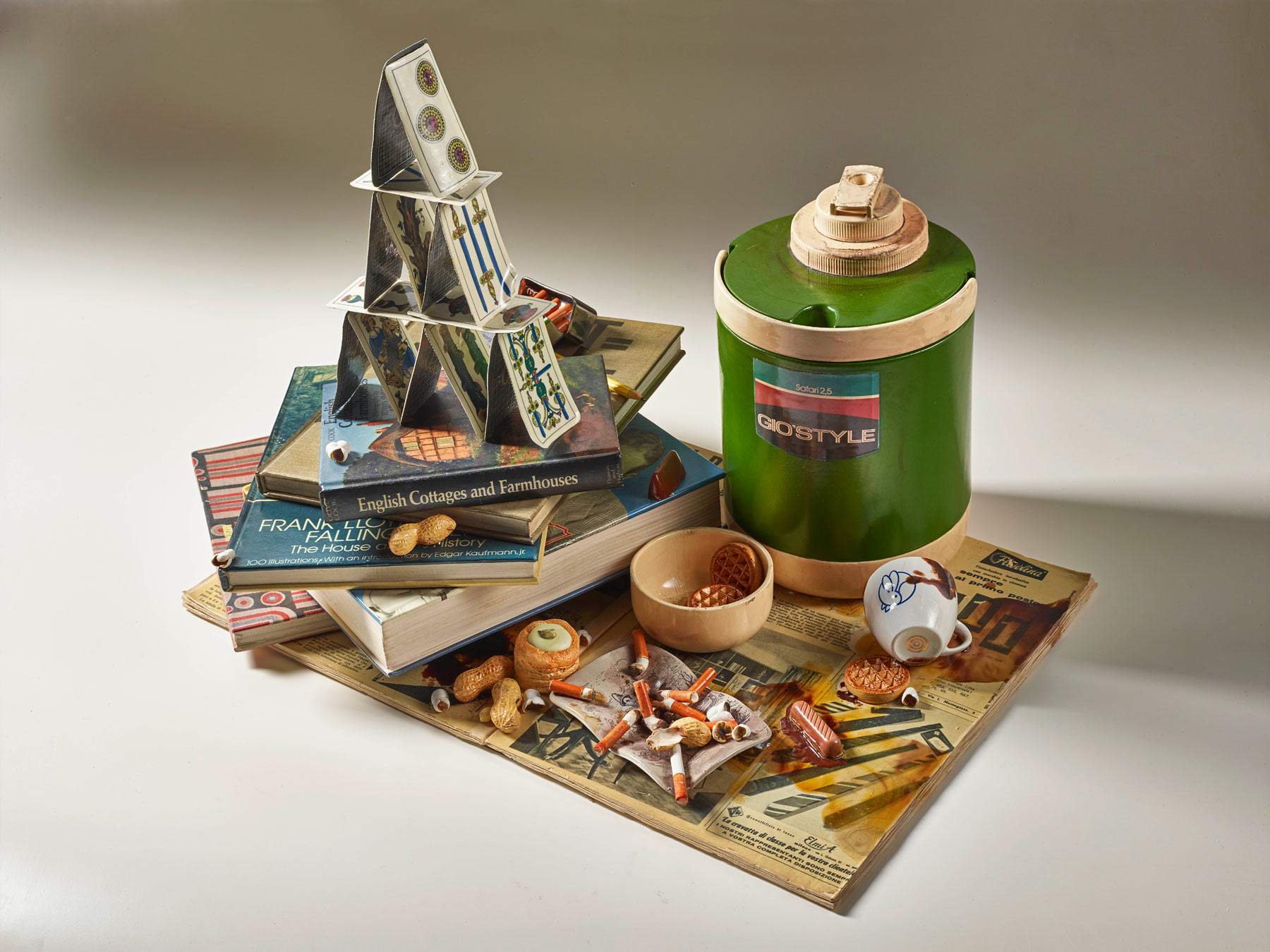

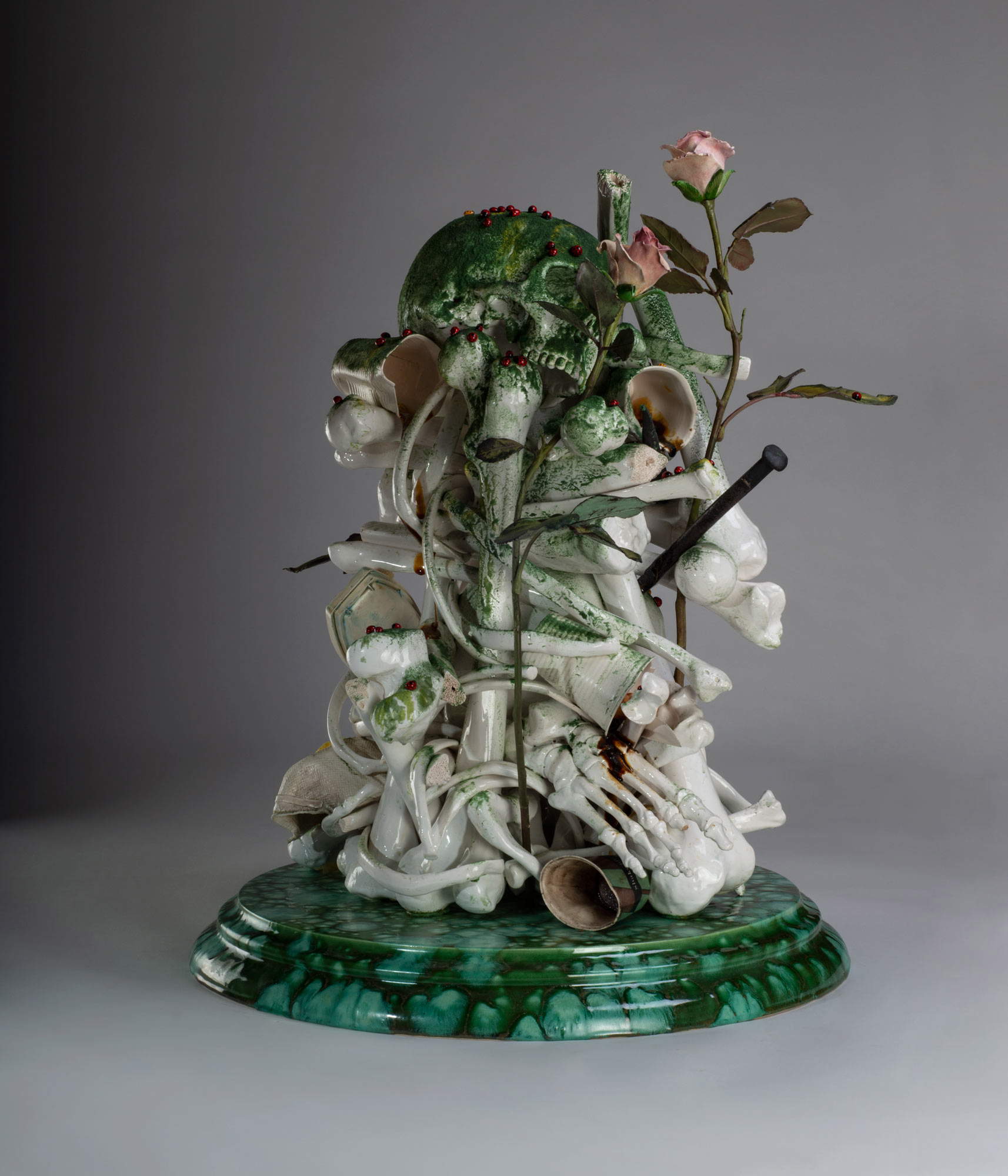
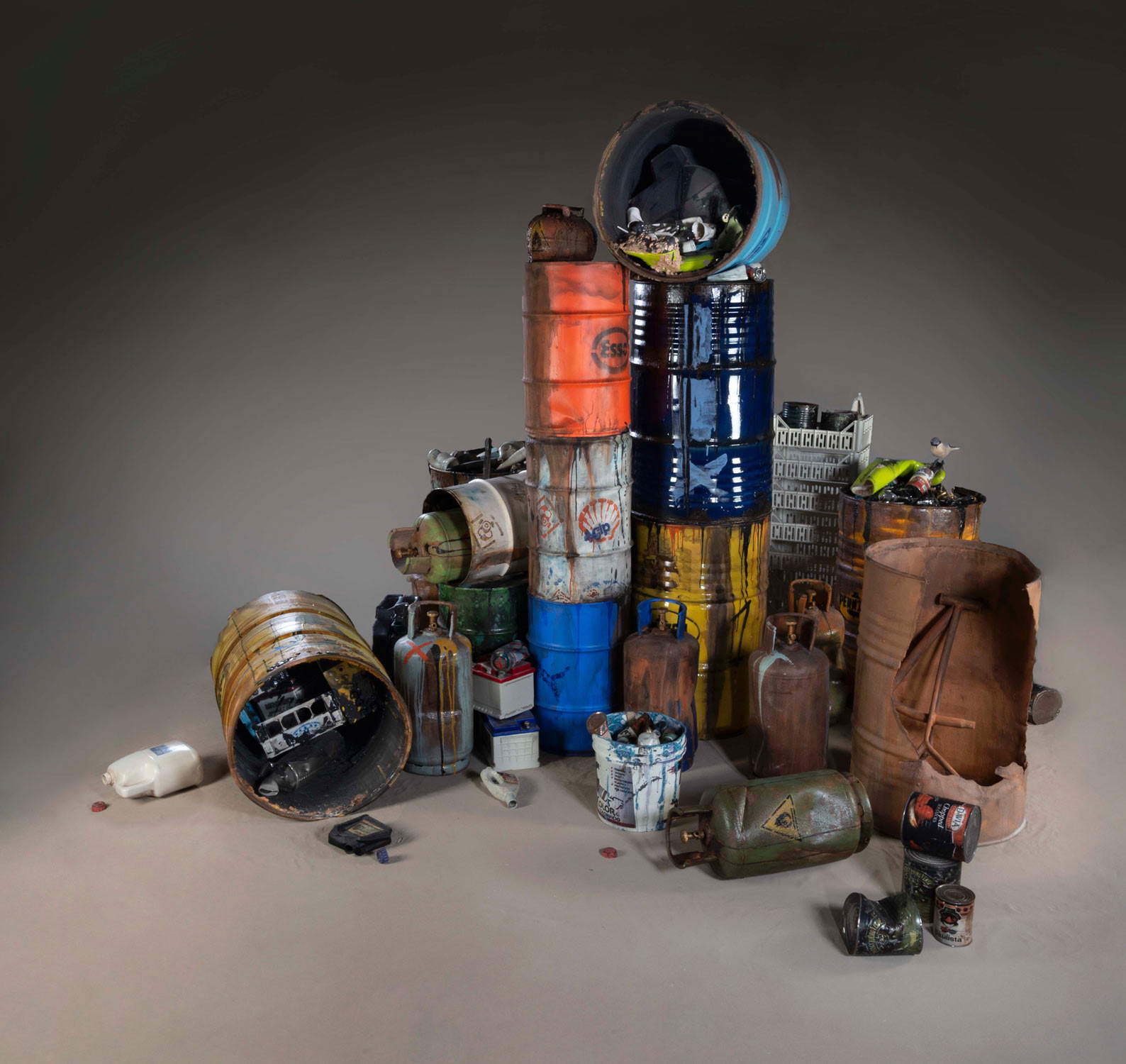
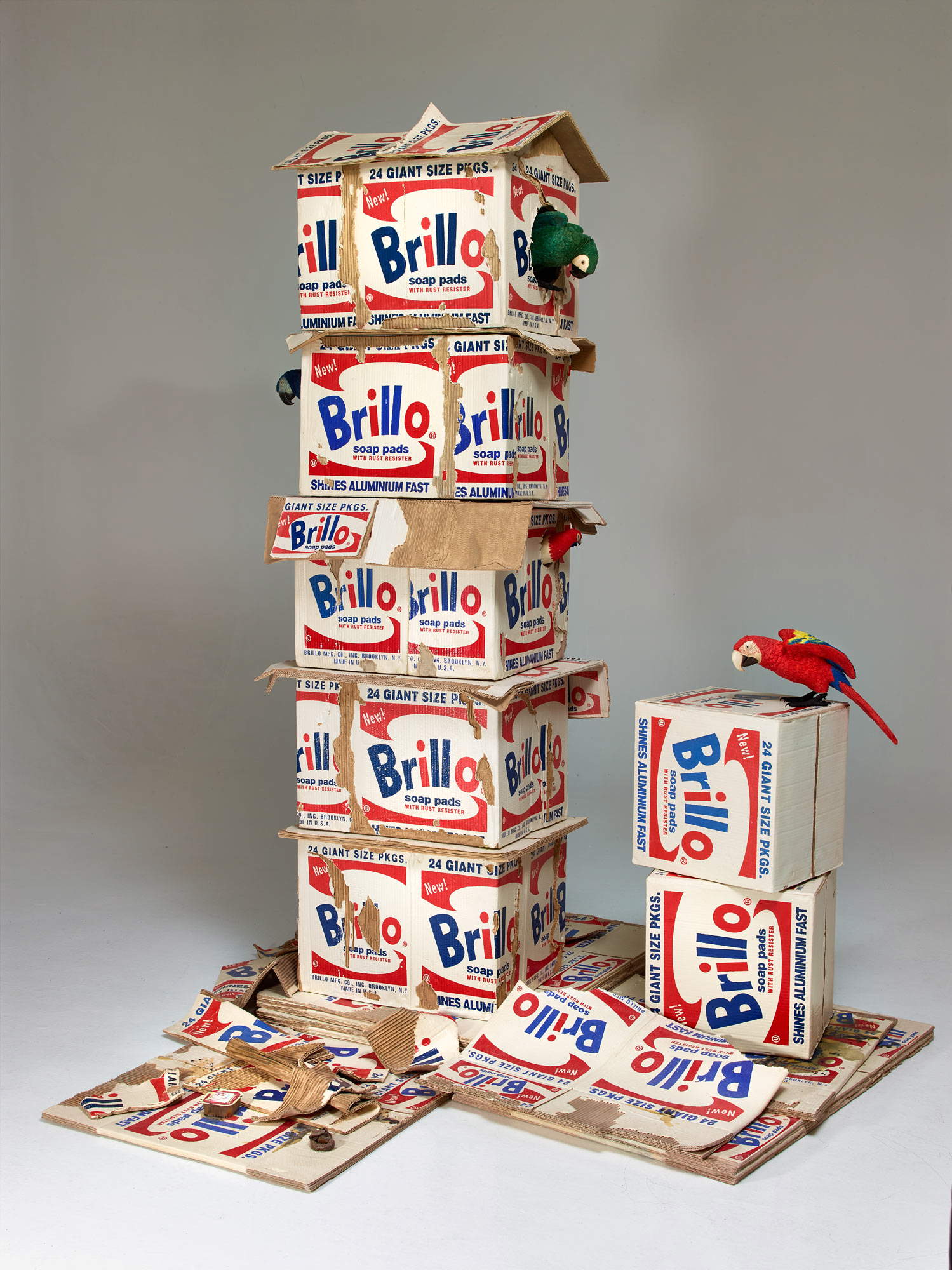
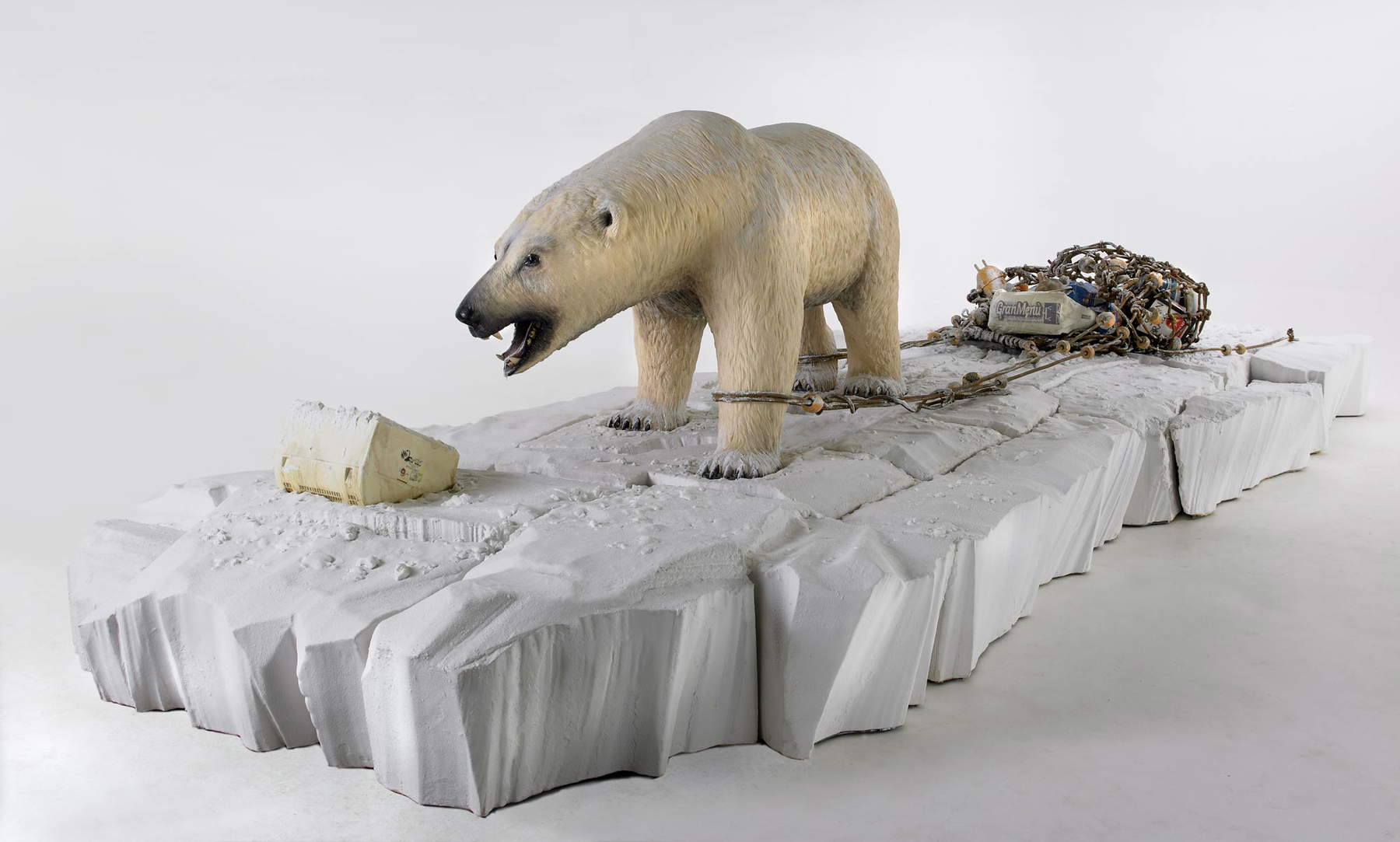


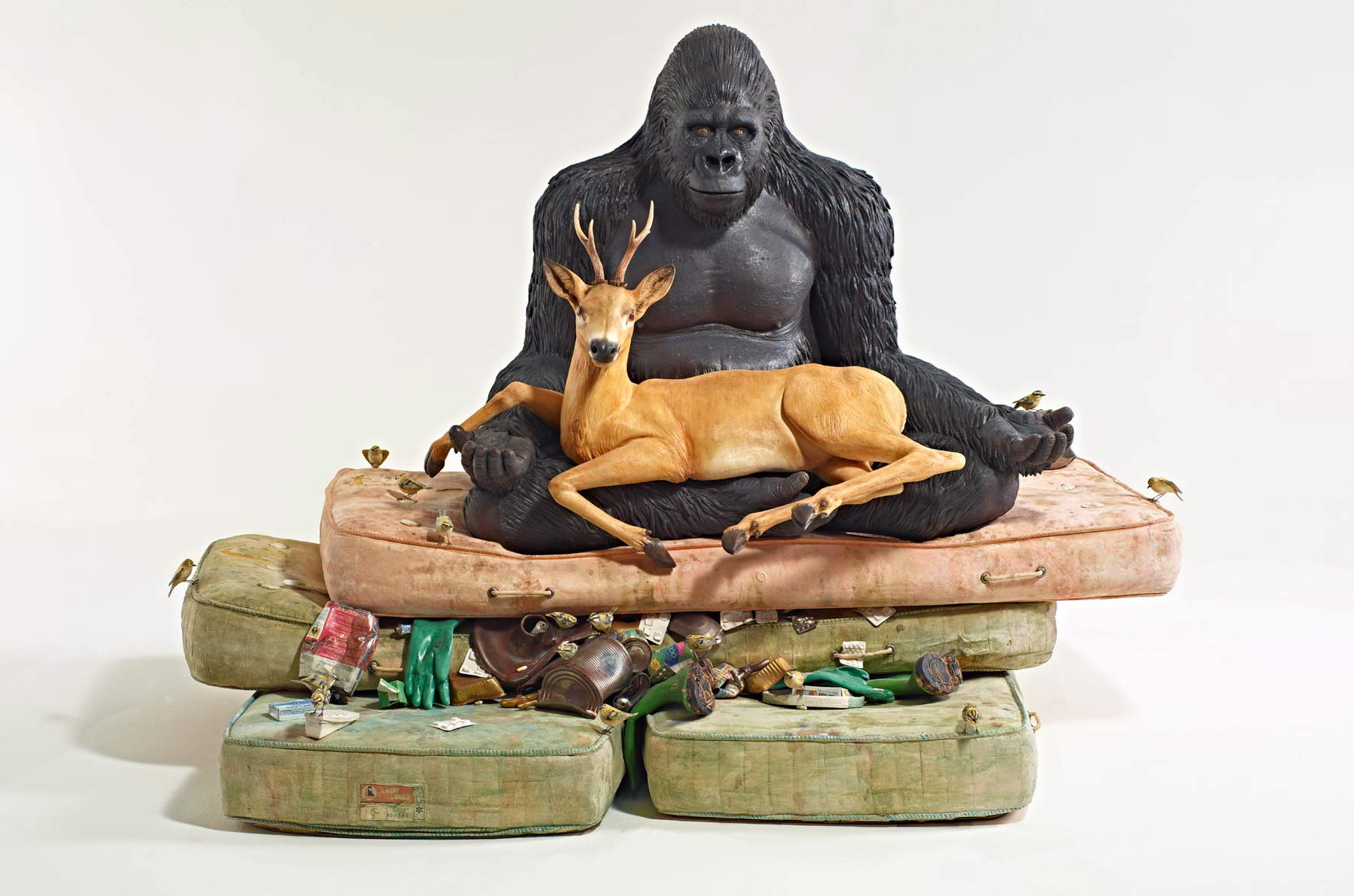
Natural to grasp then, in these leftovers of time, the reference to the fleetingness of our existences: vanitas is another of the pillars of Bertozzi & Casoni’s work, perhaps the most long-lived ("no doubt that Bertozzi & Casoni’s work is an uninterrupted memento mori“Vittorio Sgarbi has said), and came without any intermediary from the artistic and scientific work of the French ceramist Bernard Palissy, one of the first Europeans to have intuited the organic origin of fossils, as well as the inventor of a ”rustic" ceramic that involved imitating, directly on the plates, the animals (snakes, fish, lizards, shrimps, salamanders, butterflies) that the artist saw in the swamps of Saintonge, his homeland. Palissy had understood that fossils were traces, the remains of an ancient existence, and had taken to using the plaster cast technique not only to obtain images that were as truthful as possible, but perhaps also to imitate, to a certain extent, the natural process of fossilization: by preserving in the works of art the appearance of the real, and thus making it incorruptible, he was affirming, through an obvious paradox, the ephemeral condition of the creatures that populated his ceramic plates. Bertozzi & Casoni sought to renew the tradition of vanitas, looking specifically at seventeenth-century art and not only at Palissy’s, “bringing within it the contemplations of our present,” as they themselves put it, “disaster and beauty is what we try to stage.”
The precariousness of the human condition emerges from the leftovers of the consumerist maelstrom that sucks our society, chews it up, and expels corrupted and colorful scraps, which in preserving the shell of what has been reminds the relative of what was and what will be. Bertozzi & Casoni’s wastes retain the trace of all the world’s weariness. Their remains are burdened by the simultaneous presence of past, present and future, and in their conscious epic of discard, always cloaked in a veil of irony, they rise to perhaps the most sincere sign of human intentions, and thus become on the one hand objects of extraordinary aesthetic potential (“the abandoned can of tuna fish,” says Giampaolo Bertozzi, “is an admirable object, of great artistic quality, of a great sensitivity of colors, of variations of tones, from rust to the discoloration of the label”), and on the other hand a powerful and eloquent symbol of transience, where beauty is never completely obscured, but is rather an inescapable element because it suggests an alternative, an after and an elsewhere.

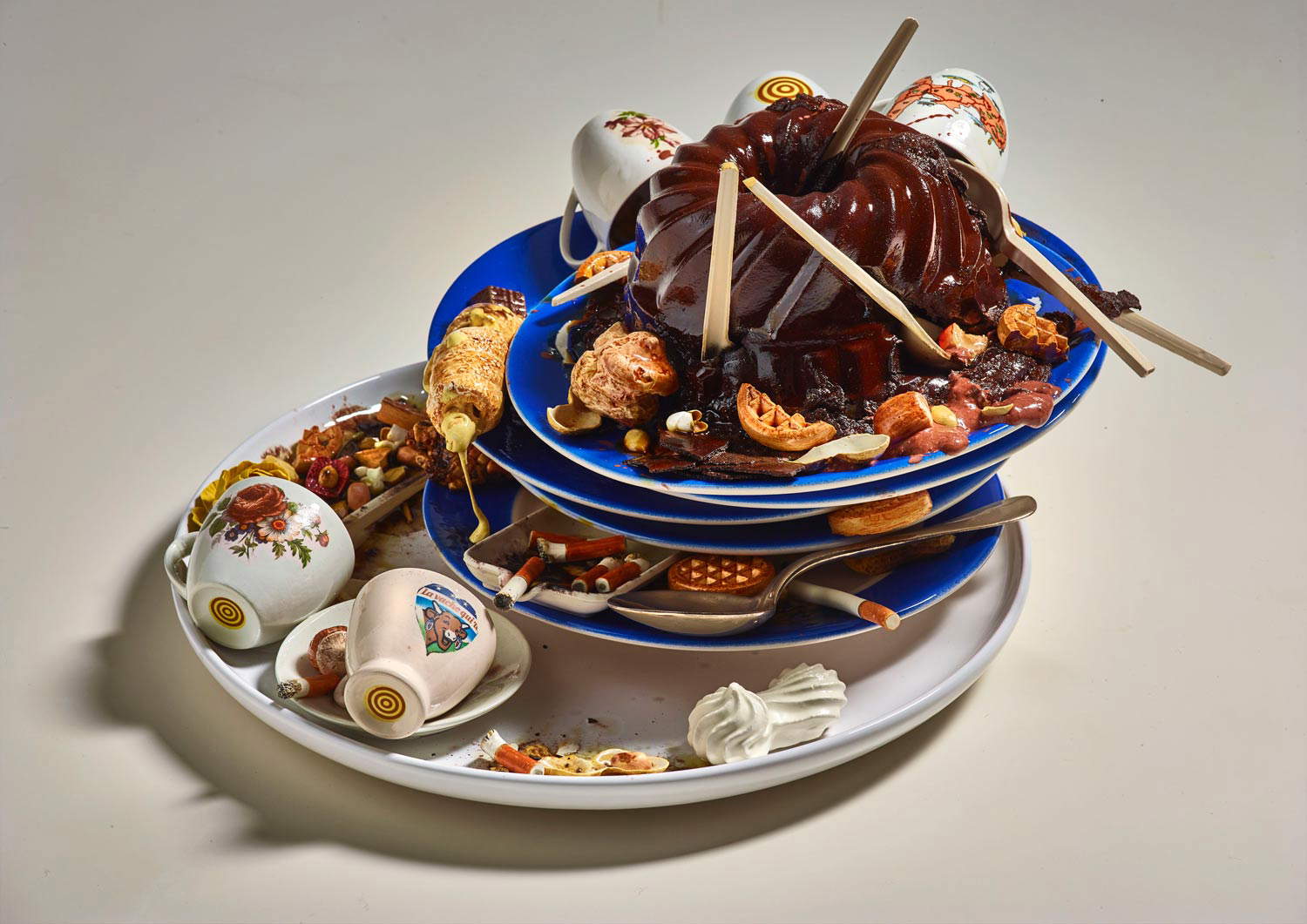
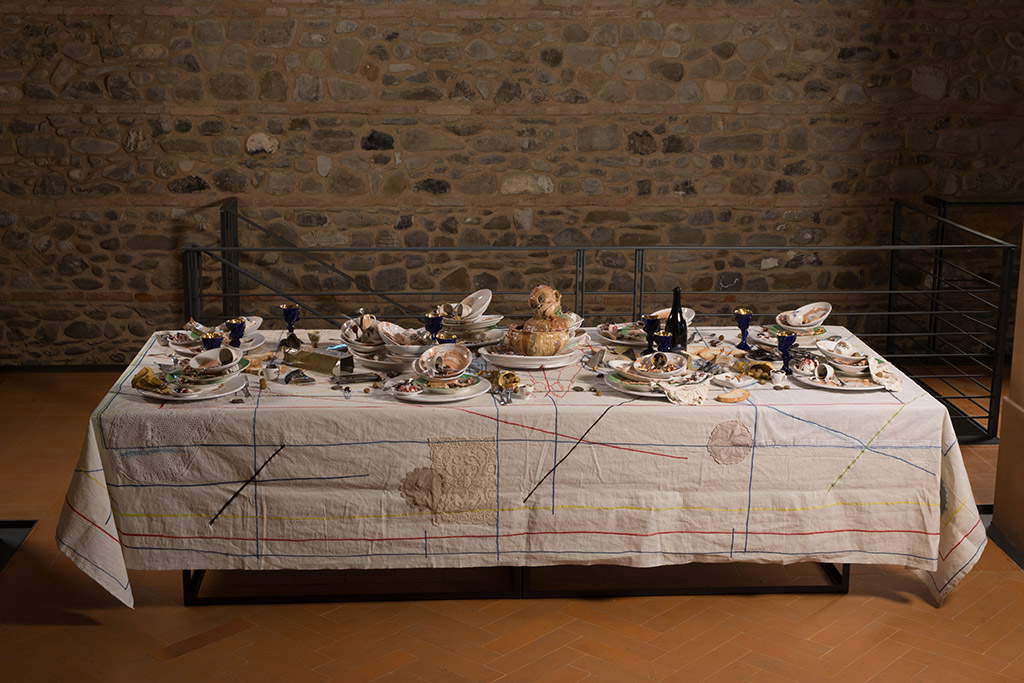
It should be added then that this sense of precariousness is further suggested by the expressive medium that Bertozzi & Casoni have chosen, ceramics, at once eternal and fragile, invested even with a certain sacredness precisely by virtue of its nature, which leads the relative to admire it with respect, almost with deference, and consequently to inspire that contemplative dimension that Giampaolo Bertozzi and Stefano Dal Monte Casoni have always sought, going so far as to coin the definition of “contemplations on the present” for their accumulations. Contemplations that have added an extremely significant chapter to the history of ceramics: with an original language far removed from any epigonal derivation, Bertozzi & Casoni have revived the tradition of an art that, especially in Italy, has often been considered secondary, despite a very happy season in the 1960s, when observing ceramic works in important contexts meant catching up with Lucio Fontana’s innovations (those that would anticipate the Attese: Without the infinite possibilities of ceramics, the road traveled by Fontana would probably have known other detours), on those of Leoncillo, Fausto Melotti, Mario Ceroli, Arturo Martini, Nino Caruso, and an interesting revival in the last twenty to thirty years, with the names of Luigi Ontani, Giuseppe Ducrot, Luigi Mainolfi and others who have probed further possibilities. Possibilities which, Bertozzi & Casoni, translate into supreme technical skill not for the sake of being more real than real: that is not the goal, although one can safely refer to them as masters without the fear of using what increasingly appears to be a courtesy appellation, and thus without the fear of deriving some embarrassment from it. Bertozzi and Casoni really master the technique, they really know its innermost secrets, and behind the successful exhibitions in the most authoritative contexts there is all the dust raised in the long journey that started from the kilns of the Emilian province, from the school, from the State Institute of Ceramics in Faenza, passed through the collaborations with the Academy of Bologna, with the cooperatives of local ceramists, continued with the debuts in the world of design in a period, the 1980s, when ceramics had again left the orbits of the most current languages (and, mind you, it will not be necessary to speak of fashions: Bertozzi & Casoni have never followed them), until they reached the exploration of those new horizons, almost revolutionary one might say without fear of exaggeration (anyone who approaches ceramics will not be able to question the status achieved after Bertozzi & Casoni), toward which their art continued to look.
No virtuosity that only aspires to mere bewilderment or, even worse, basks in autolatry: the works of Bertozzi & Casoni are born to be probed in depth, their assemblages preserve a tension, sincere and casual, that leads them to connect the great history of art with the most urgent questions and with the most eternal ones, and they are enveloped by a pungent and fascinating ambiguity that engages in a continuous challenge against our certainties and our convictions, and that induces the relative, without any prejudice, to investigate the mystery that twists our existences. Franco Bertoni has rightly recalled that Bertozzi & Casoni are “masters of doubt” and that their art raises uncertainty and disquiet: “Rarely, before them, had art, in this case with ceramics, reached such high levels of hypnotic executive perfection, and it is precisely to their unassailable works that we owe the merit of having done justice to ancient and recent misunderstandings of a medium considered marginal and instead endowed with a singular and irreplaceable capacity for language.” It is singular, and in some ways even touching, to think that Bertozzi & Casoni still work with ancient techniques, which cannot be reproduced by mechanized means, in a slow, meticulous, often repetitive process, in which boredom and loneliness often, inevitably, also take over. But then again, it is perhaps true that one is not a true artist if one has not experienced some form of solitude.
Warning: the translation into English of the original Italian article was created using automatic tools. We undertake to review all articles, but we do not guarantee the total absence of inaccuracies in the translation due to the program. You can find the original by clicking on the ITA button. If you find any mistake,please contact us.